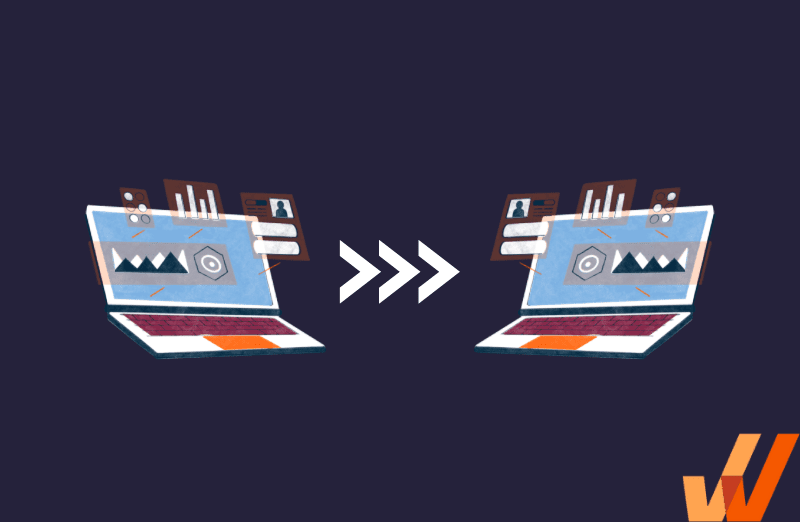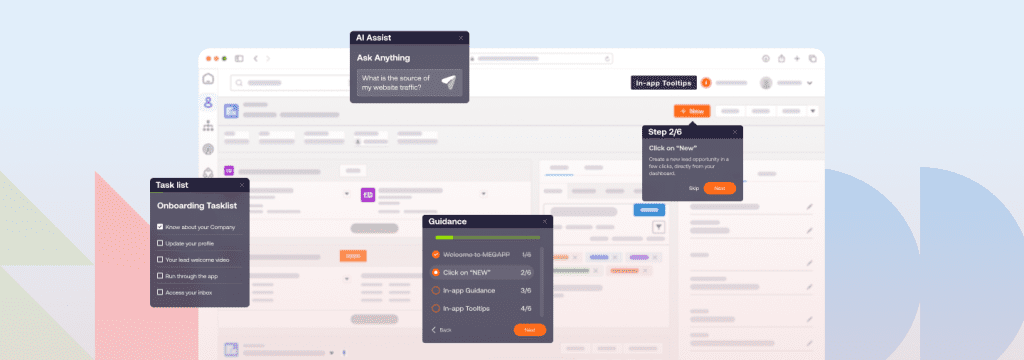Change management is foundational for organizational development and growth. Organizations that embrace and adapt to change succeed; however, many businesses shy away from transformational change projects in favor of the status quo due to these initiatives’ challenges and risks.
Change management models enable organizations to navigate through change and transitional phases by guiding team members toward adopting new digital applications, processes, workflows, and more – allowing businesses to maximize ROI from digital transformation initiatives.
One of the most influential theories for understanding organizational change is Kurt Lewin’s 3-step change model, which balances the driving and restraining forces to manage organizational change in three core phases: unfreezing, changing, and refreezing.
What Is Lewin’s Change Model Theory?
Kurt Lewin’s change model states that restraining forces influence the behavior of organizations and individuals, ultimately deciding the fate of change. The driving forces motivate and steer employees toward the new state. The restraining forces highlight potential resistance to change, acting as the prime barriers to change initiatives. Lewin’s three stages of change included:
- Unfreeze: Preparing for a desired change.
- Change: Implementing the desired change.
- Refreeze: Solidifying and adopting the desired change.
Lewin suggests that it is crucial to balance these forces through effective change communication and employee involvement by providing training to bridge the skill gap. Change agents must implement stress management techniques, ensure compliance is met, and use convincing change reasoning.
The 3 Stages of Change in Lewin’s Model
To substantiate his Force Field Theory, Lewin suggested a straightforward three-step change model that aids employees’ ability to adapt to change: unfreezing, changing, and refreezing.

Stage 1 – Unfreeze
The first stage in Lewin’s model deals with perception management and aims to prepare the affected stakeholders for the upcoming organizational change. Change leaders must look at ways to improve the company’s preparedness for change and create a sense of urgency similar to Kotter’s change model.
During this stage, effective change communication is vital in getting the desired team members buy-in and support of the people in the change management.
The following activities under the ‘unfreeze’ stage will help you embrace change better:
- Conduct a business process analysis to understand the current loopholes in the business processes
- Obtain organizational buy-in
- Create a strategic change vision and change strategy
- Communicate in a compelling way about why change has to occur
- Address employee concerns with honesty and transparency
Stage 2 – Change
Once the status quo is disrupted, this stage deals with implementing change. To smoothen the transition, you must consider an agile and iterative approach that incorporates employee feedback.
You can further look at the following actionable items to keep uncertainty at bay:
- Ensure a continuous flow of information to obtain the support of your team members
- Organize change management workshops and sessions for change management exercises
- Empower employees to deal with the change proactively
- Generate easy wins as visible results will motivate your team
Stage 3 – Refreeze
Employees move from the transition phase towards stabilization or acceptance in the final’ refreezing’ stage.
However, if change leaders fail to reinforce the change in organizational culture, employees might revert to previous behaviors.
The following activities will help you support the change.
- Identify and reward early adopters and change champions
- Collect employee feedback regularly
- Offer on-demand employee training and support
- Explore digital adoption platforms (DAP) such as Whatfix to be your partner in change with intuitive features such as interactive walkthroughs, customizable popups, and multi-format self-help content.
How Can Lewin’s Change Model Be Implemented?
Here are five significant ways that Lewin’s 3-stage change model can be applied to organizational change, including:
1. Changing the behavior and skills of a workforce
More often than not, every change initiative requires behavior modification and continuous upskilling of employees. Building on an existing skillset allows employees to take over more responsibilities. Therefore, offering ongoing employee training is crucial until the change is second nature.
2. Changing the processes, structures, and systems in an organization
Successful change initiative requires a balanced approach to changing the business processes, structures, and systems.
For example, McDonald’s incurred a multi-billion dollar loss due to its inability to balance innovation against process efficiencies. It failed to recognize how extensive customization to its food preparation would impact its speed and increase operational costs.
3. Changing the culture of an organization
McKinsey suggests that companies with a strong culture achieve up to three times shareholder returns. To reap the long-term benefits of any change initiative, you must anchor the changes in org culture.
For example, Hubspot values culture and product equally. It has an extensive 128-page culture code check to ensure that its culture stays strong as ever. Additionally, Hubspot takes an employee-first approach and invests heavily in employee development and upskilling.
4. Changing the technology used
To ensure the successful adoption of new technology, organizations should create a sense of urgency, evaluate their current technology, prepare for the change, implement the new technology, and establish its long-term viability.
This approach can minimize failure risks, make the transition smoother, and enable organizations to reap the benefits of the new technology
5. Changing the product or service
When making changes to your product or service, it’s important to act quickly, evaluate the current offering, create a new plan, and integrate it into your company’s culture and processes. By following this change model, your organization can reduce the risk of failure, guarantee a successful implementation, and achieve your desired results.
5 Challenges of Lewin’s 3-Stage Model in Action
Organizational change is rarely straightforward, and implementing Lewin’s change model can present several unique challenges. From resistance to change to breakdowns in communication, organizations must be prepared to navigate various obstacles to manage change effectively.
1. Resistance to change
People often hesitate to change their habits, routines, and working methods, which can create resistance and pushback against the change initiative. This resistance can take different forms, such as skepticism, fear, anxiety, or outright opposition.
If resistance to change is not addressed, it can ruin the change initiative and prevent it from success. As a result, it’s crucial to identify and understand the reasons for resistance and address them effectively. This may involve providing clear communication and education about the reasons for the change, involving employees in the change process, addressing concerns and fears, and providing support and resources to help employees adapt to the change.
2. Lack of leadership support
Successful change initiatives require strong leadership and guidance. When leaders actively support and promote change, employees are much more likely to prioritize it and understand its importance. Leadership is crucial in setting the tone for change by providing direction, resources, and alignment with the organization’s vision and goals. Without strong leadership, employees may feel uncertain and unsupported, leading to resistance and disengagement.
To prevent this, leaders must communicate the vision, provide guidance and resources, and involve employees in the change process. By demonstrating their support for the change initiative, leaders can build momentum, create buy-in, and increase the likelihood of successful implementation.
3. Inadequate resources
Organizations need to allocate sufficient time, money, and other resources to make change initiatives successful. When resources are lacking, implementation can be compromised, and quality can suffer. Employees may also resist changes if they feel unsupported or overworked, making it difficult to maintain momentum.
Organizations should appropriately identify and allocate the necessary resources, whether securing more funding or staffing, re-prioritizing existing resources, or finding creative solutions to resource constraints. This will increase the likelihood of successful implementation and help achieve the desired outcomes of the change initiative.
4. Poor communication
For change initiatives to run smoothly, communication must be clear and consistent. Poor change communication can lead to confusion, skepticism, or resistance among employees, making it difficult to build engagement and sustain the change over time.
To avoid this, develop a clear communication plan that outlines the key messages, channels, and timing for communication throughout the change process. The plan should be tailored to the needs and preferences of different stakeholders and delivered promptly and consistently.
5. Inadequate training
Employees must receive proper employee training and end-user support to implement change initiatives successfully. Failing to do so can result in frustration, mistakes, and resistance among employees, ultimately hindering the change effort’s success.
To prevent this, invest in creating effective training materials, conducting workshops, providing coaching, and offering ongoing feedback and support. By taking these steps, organizations can greatly increase their chances of achieving the desired outcomes and ensure that employees possess the knowledge and skills necessary to support the change initiative.
10 Enterprise Scenarios for Applying Lewin’s Change Model
- Implementing New Technology: Communicate the need for new enterprise software, provide end-user training for employees, and phase out the legacy system(s). Solidify the change by embedding the technology into daily workflows and providing ongoing support.
- Restructuring an Organization or Consolidating Teams: Highlight inefficiencies in the current organizational structure and reasons to change structure type, realign roles and responsibilities, and provide necessary new-role or managerial training. Reinforce the new structure with updated policies and team collaboration initiatives.
- Acquisitions or Mergers: Explain the rationale for the merger or acquisition, align corporate cultures, introduce new team members, integrate processes, and consolidate technology systems to create blended data sources. Cement the new organization with shared goals and standardized operations.
- Pricing Model Change: Present the need to transition to a new pricing model, update contracts, and train sales teams to handle customer communications. Integrate the pricing change into the business strategy and track its impact.
- Introducing New Product Lines or Revenue Streams: Identify support for product diversification, develop the new offerings, and train teams to market and support them. Incorporate new products or services into the company’s core operations and set success and adoption metrics.
- Launching a Company-Wide Digital Transformation Initiative: Address the risks of not innovating, roll out new tools, and upskill employees for digital-first operations. Foster a culture of digital innovation and ensure employees are equipped for sustained success.
- Improving Customer Experience Processes: Identify friction points in the customer journey, redesign workflows, and implement new tools like CRM systems. Reinforce improvements with feedback loops and institutionalized continuous CX improvement best practices.
- Adapting to Regulatory Changes: Educate employees about new regulations, update policies and processes, and provide compliance training to all impacted teams. Establish compliance as a core company value and conduct regular audits.
- Shifting to a Remote or Hybrid Work Model: Highlight the benefits of flexibility, deploy collaboration tools, and revise HR policies. Integrate the new work model into the culture with performance tracking and regular feedback.
- Establishing Sustainability Practices: Communicate the importance of sustainability, implement eco-friendly policies, and reduce waste. Make sustainability a core part of business objectives and recognize green initiatives.
3 Examples of Lewin’s 3-Stage Model in Action
To understand Lewin’s change theory, let’s explore three examples of successful organizational change that applied Lewin’s three-step model.
1. Nissan’s financial restructuring and Renault alliance
Nissan Motor Company was on the verge of bankruptcy due to its financial debt and constantly declining market share.
To overcome this, Nissan entered a strategic alliance with Renault. Powered by change agent Carlos Ghosn, Nissan built a plan to shed its financial debt and expand Renault’s market share.
Carlos Ghosn faced the challenge of implementing a transformational change and turning around Nissan’s operations to make them profitable.
- He prepared by forming cross-functional teams that understood the core problem, had the skills to create effective change action plans, and could influence employees to adopt transformational change.
- He developed a strong change management strategy that tackled various business challenges and increased employee involvement in the change journey through effective communication and positive reinforcement.
- To refreeze the behavioral change of the team members, he introduced performance-based pay, empowered employees to try non-conventional methods, and implemented an open feedback system for guiding and facilitating the employees in enhancing workplace adaptability.
2. McDonald’s overhauled its business model in response to changing consumer preferences
In 2017, McDonald’s recognized that its traditional fast-food model was losing market share as consumer preferences evolved. Using Lewin’s 3-Stage Change Model, the company unfreezed its existing practices, implemented significant operational changes, and refroze its new strategies into its culture and policies.
- Unfreeze: McDonald’s leadership communicated the need for change, explaining why the traditional fast-food model was no longer effective and presenting the benefits of modernization to employees.
- Change: The company introduced all-day breakfast, customizable menu options, and updated in-store technology to align with customer feedback and modern expectations.
- Refreeze: McDonald’s incorporated the new business model into its policies and culture, rewarded employees who adapted successfully, and ensured ongoing monitoring and refinement of its strategies.
McDonald’s fully implemented the changes and was then able to evaluate their success. The necessary adjustments were made, and the new business model was solidified by incorporating it into the company’s policies and culture. Employees who adapted to the changes were recognized and rewarded, and the company continues to monitor and assess the effectiveness of its business model and operations.
3. Nokia pivots to smartphone technology
In the mid-2000s, Nokia dominated the global mobile phone market with its feature phones. The company eventually realized that the market was shifting towards smartphones, and to remain competitive, it needed to adjust its business model and technology.
- Unfreeze: Nokia’s leadership communicated the market shift to employees and outlined the shortcomings of the feature phone model to rally support for change.
- Change: The company introduced its Symbian smartphone platform, partnered with Microsoft on the Windows Phone platform, and focused on delivering advanced user experiences like touchscreens and high-quality cameras.
- Refreeze: Nokia integrated its new technology and business model into its culture, evaluated outcomes, rewarded employees for adapting, and made continuous improvements to refine its strategies. Despite resistance from employees accustomed to the traditional feature phone model, Nokia’s leadership team continued to convey the benefits of the changes. It provided employees with the necessary resources and training to adapt to the new technology.
After fully implementing the changes, Nokia thoroughly assessed its success and made the necessary adjustments. The new business model and technology were seamlessly integrated into the company’s policies and culture. Nokia prioritized acknowledging and rewarding its employees for their efforts in adapting to the changes.
Change Clicks Better With Whatfix
It’s clear that Lewin’s change model framework has stood the test of time and remains a valuable tool for organizations looking to navigate change. From the unfreezing stage to the refreezing stage, Lewin’s change model provides a comprehensive roadmap for managing the complex organizational change process.
With Whatfix, organizations can enable end-users through times of change and maximize the value realization of digital transformation projects.
Create simulated application training environments with Mirror
Whatfix Mirror enables L&D leaders to easily create replicate sandbox environments for your enterprise software and its tasks and workflows. This provides hands-on training to employees, allowing them to learn in a risk-free, interactive sandbox application.

Support employees in the flow of work with in-app guidance
With Whatfix DAP, use a no-code editor to create in-app guidance and onscreen overlays to support employees in the flow of work and ensure process governance. Quickly onboard new team members with Tours and Task Lists. Guide employees through complex workflows or infrequently done tasks with Flows and Smart Tips. Self Help integrates with your knowledge repositories, bringing an in-app user support center directly into your enterprise applications.

Ready to get started? Request your Whatfix demo now!








